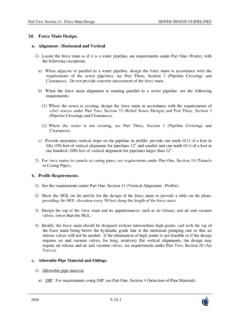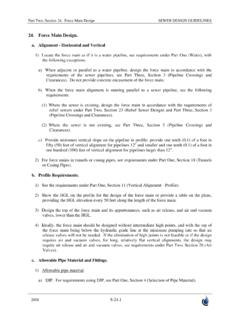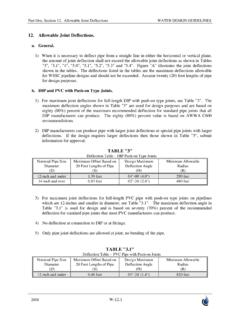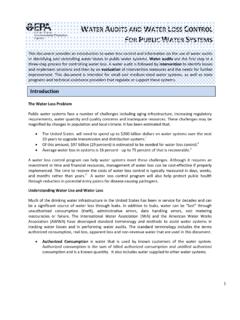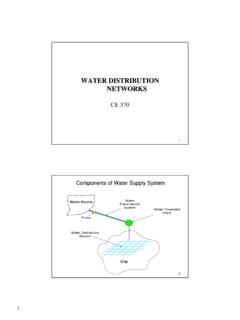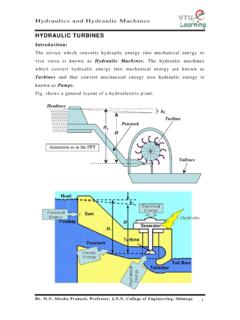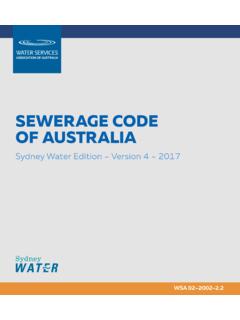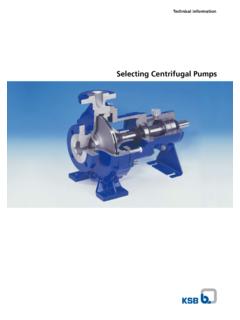Transcription of 17. Manhole Channel Design. - WSSC Water
1 Part Two, Section 17. Manhole Channel Design SEWER DESIGN GUIDELINES 2008 17. Manhole Channel Design. a. General. 1) When referencing the pipe invert elevations on the profile, provide the inverts of all pipes entering and exiting the Manhole . 2) Pipes entering the Manhole (in) can be at the same invert elevation if more than one pipeline is coming in the Manhole and the pipelines are the same diameter. If the pipelines are not the same diameter, see Channel Slope, in this section. 3) Design the pipe exiting the Manhole (out) at a lower invert elevation, see Channel Slope, in this section.
2 4) Channels for specially designed manholes and structures. When a Manhole or structure is not in accordance with the Standard Details, provide all necessary dimensions, radius, etc., on the drawings to construct the Manhole . Design the Channel to conform to Standard Detail b. Channel Slope. 1) Design the drop or Channel slope across the pipe inverts as follows: a) Minimum drop between pipe inverts on mainline flow (in and out), same size diameter, design as follows and see requirements under angles between pipe entering manholes, in this section. (1) For sewer pipelines 12-inch and smaller diameter, provide minimum drop of foot. (2) For sewer pipelines larger than 12-inch and smaller than 36-inch diameter, provide minimum drop of foot or determine hydraulic loss for determine minimum drop across the pipe inverts.
3 (3) For sewer pipelines 36-inch and larger diameter, the drop across the pipe invert may have to be less than the foot minimum. Determine hydraulic loss through the Manhole and if greater than the minimum drop, provide drop equal to or greater than the hydraulic loss. b) Maximum drop between pipe inverts entering and leaving the Manhole , same size diameter, design as follows: (1) For sewers pipelines 12-inch and smaller, the maximum drop is one (1) foot without providing a drop connection. (2) For sewer pipelines larger than 12-inch, determine the hydraulic loss through the Manhole and provide drop equal to or greater than the hydraulic loss.
4 If design requires larger drop than calculated, a drop connection may be required. c) Angles between pipes entering manholes. (1) Consider the hydraulic losses created by sharp angles of pipes entering and leaving the manholes. Part Two, Section 17. Manhole Channel Design SEWER DESIGN GUIDELINES 2008 (a) Provide an angle of ninety (90 ) degrees or greater between the pipes entering and leaving the Manhole . (b) For 12-inch and smaller sewer pipelines, when the angle of the pipes entering and leaving the Manhole is between ninety (90 ) degrees to one hundred twelve and one half ( ) degrees, see Table 16 and Sketch U for minimum drop.
5 TABLE "16" Angles Between Pipes 12-inch and Smaller Entering Manholes and Minimum Drop Across Channel Inverts Angle, see Sketch U Angle Between Pipes Entering Manhole Minimum Drop Across Channel Inverts Minimum Drop Across Channel Inverts with Increased Radius of Channel /Diameter of Manhole "A" 90 to feet Or feet and Increase Channel radius to feet and 6'-0" diameter Manhole "B" to 135 feet Or Increase Channel radius to feet and 6'-0" diameter Manhole . Angles Between Pipes 12" and Smaller Entering ManholesSKETCH "U"90 135 Sewer PipelineSewer Pipeline entering manholeSee Angle "B", Table 16 for Channel requirements for Channel requirementsleaving Manhole d) Different pipe diameter entering and exiting the Manhole , design invert elevations as follows: (1) For sewer pipelines 12-inch and smaller, design the pipe invert elevations matching either the 5/6 flow depth of the different pipe diameters or the pipe crowns of the inlet and outlet pipes.
6 Part Two, Section 17. Manhole Channel Design SEWER DESIGN GUIDELINES 2008 (a) Matching the 5/6 flow depth may result in the crown of the larger pipe being slightly higher than the crown of the smaller pipe . In this case, adjust the larger pipe so that its crown matches that of the smaller pipe . (b) The invert of the outlet pipe shall be lower than the invert of the inlet pipe . Example A: 6-inch SHC is entering the Manhole at an invert elevation of and an 8-inch Sewer Pipeline is exiting the Manhole . First, determine the 5/6 flow of each pipe . 5/6 of 6" SHC = ' 5/6 of 8" S = ' Then subtract 5/6 flows ( from ).
7 The difference in flows or inverts would be ', which will make the invert of the 8" sewer leaving the Manhole at an elevation of In this case, the inside top of the 6-inch SHC entering the Manhole will be at an elevation of and the inside top of 8-inch Sewer Pipeline exiting the Manhole will be at an elevation of In this case match the crowns elevations of the 6-inch SHC entering the Manhole and the 8-inch Sewer Pipeline is exiting the Manhole . Matching crowns the difference in inverts will be ', which will make the invert of the 8" sewer leaving the Manhole at an elevation of , see Sketch "V". (2) Exception to matching the 5/6 flow depths or matching the crowns.
8 (a) When one of the incoming pipelines is opposite (135 to 180 as shown on Sketch "W") the other incoming (in) pipeline, see Sketch "W". In this condition, the invert of the smaller incoming pipeline must be set at a higher elevation than the invert of the larger pipe to avoid flow from the large pipe from entering the smaller pipe . This is accomplished by either: matching the crowns of the two pipes, then raising the invert of the smaller pipe by SKETCH "V" Manhole Channel DesignMatching Crown ElevationsInvert Elevation Elevation 8"S 6"SHC (in) Part Two, Section 17. Manhole Channel Design SEWER DESIGN GUIDELINES 2008 feet, or matching the 5/6 flow levels, then raising the invert of the smaller pipe by feet.
9 The method resulting in the higher invert elevation for the smaller pipe is to be used. (3) For sewer pipelines larger than 12-inch diameter and up to 27-inch diameter, design the pipe invert elevations by matching the crowns of the different diameter pipes. Determine hydraulic losses to verify the design. (4) For sewer pipelines larger than 27-inch, design the pipe invert elevations by matching the crowns of the different diameter pipes. For sewer pipelines larger than 27-inch diameter, with 12-inch and smaller laterals entering the Manhole , design the laterals by matching the invert to or above the crown of the larger pipe to prevent flow from the larger pipe entering the smaller pipe .
10 Determine hydraulic losses to verify the design. e) When the drop across the inverts (in and out) is greater than one (1) foot, adjust the inverts to suit the maximum one (1) foot drop or design the Manhole with a drop Manhole connection, see requirements under Part Two, Section 16 ( Manhole Drop Connections). f) Evaluate drops across pipe inverts larger than foot for hydrogen sulfide generation, see Part Two, Section 28 (Hydrogen Sulfide (H2S) Control) and Part Two, Section 16 ( Manhole Drop Connections). c. Radius of the Channel . 1) For sewer pipelines smaller than 12-inch diameter, provide a minimum radius of the centerline of the Channel of one-half (1/2) the inside diameter (ID) of the Manhole , see Sketch X.
